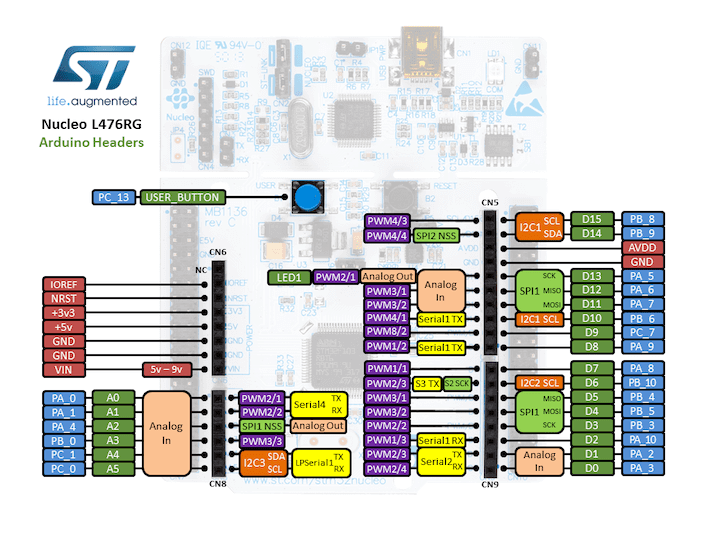If you need urgent consulting help click here
ST Nucleo L476RG
Overview
The Nucleo L476RG board features an ARM Cortex-M4 based STM32L476RG MCU with a wide range of connectivity support and configurations. Here are some highlights of the Nucleo L476RG board:
STM32 microcontroller in QFP64 package
Two types of extension resources:
Arduino Uno V3 connectivity
ST morpho extension pin headers for full access to all STM32 I/Os
On-board ST-LINK/V2-1 debugger/programmer with SWD connector
Flexible board power supply:
USB VBUS or external source(3.3V, 5V, 7 - 12V)
Power management access point
Three LEDs: USB communication (LD1), user LED (LD2), power LED (LD3)
Two push-buttons: USER and RESET

More information about the board can be found at the Nucleo L476RG website.
Hardware
The STM32L476RG SoC provides the following hardware IPs:
Ultra-low-power with FlexPowerControl (down to 130 nA Standby mode and 100 uA/MHz run mode)
Core: ARM® 32-bit Cortex®-M4 CPU with FPU, frequency up to 80 MHz, 100DMIPS/1.25DMIPS/MHz (Dhrystone 2.1)
Clock Sources:
4 to 48 MHz crystal oscillator
32 kHz crystal oscillator for RTC (LSE)
Internal 16 MHz factory-trimmed RC ( ±1%)
Internal low-power 32 kHz RC ( ±5%)
Internal multispeed 100 kHz to 48 MHz oscillator, auto-trimmed by LSE (better than ±0.25 % accuracy)
3 PLLs for system clock, USB, audio, ADC
RTC with HW calendar, alarms and calibration
LCD 8 x 40 or 4 x 44 with step-up converter
Up to 24 capacitive sensing channels: support touchkey, linear and rotary touch sensors
16x timers:
2x 16-bit advanced motor-control
2x 32-bit and 5x 16-bit general purpose
2x 16-bit basic
2x low-power 16-bit timers (available in Stop mode)
2x watchdogs
SysTick timer
Up to 114 fast I/Os, most 5 V-tolerant, up to 14 I/Os with independent supply down to 1.08 V
Memories
Up to 1 MB Flash, 2 banks read-while-write, proprietary code readout protection
Up to 128 KB of SRAM including 32 KB with hardware parity check
External memory interface for static memories supporting SRAM, PSRAM, NOR and NAND memories
Quad SPI memory interface
4x digital filters for sigma delta modulator
Rich analog peripherals (independent supply)
3x 12-bit ADC 5 MSPS, up to 16-bit with hardware oversampling, 200 uA/MSPS
2x 12-bit DAC, low-power sample and hold
2x operational amplifiers with built-in PGA
2x ultra-low-power comparators
18x communication interfaces
USB OTG 2.0 full-speed, LPM and BCD
2x SAIs (serial audio interface)
3x I2C FM+(1 Mbit/s), SMBus/PMBus
6x USARTs (ISO 7816, LIN, IrDA, modem)
3x SPIs (4x SPIs with the Quad SPI)
CAN (2.0B Active) and SDMMC interface
SWPMI single wire protocol master I/F
14-channel DMA controller
True random number generator
CRC calculation unit, 96-bit unique ID
Development support: serial wire debug (SWD), JTAG, Embedded Trace Macrocell™
More information about STM32L476RG can be found here:
Supported Features
The Zephyr nucleo_l476rg board configuration supports the following hardware features:
Interface |
Controller |
Driver/Component |
|---|---|---|
NVIC |
on-chip |
nested vector interrupt controller |
UART |
on-chip |
serial port-polling; serial port-interrupt |
PINMUX |
on-chip |
pinmux |
GPIO |
on-chip |
gpio |
I2C |
on-chip |
i2c |
PWM |
on-chip |
pwm |
SPI |
on-chip |
spi |
ADC |
on-chip |
ADC Controller |
Other hardware features are not yet supported on this Zephyr port.
The default configuration can be found in the defconfig file:
boards/arm/nucleo_l476rg/nucleo_l476rg_defconfig
Connections and IOs
Nucleo L476RG Board has 8 GPIO controllers. These controllers are responsible for pin muxing, input/output, pull-up, etc.
Default Zephyr Peripheral Mapping:
UART_1 TX/RX : PA9/PA10
UART_2 TX/RX : PA2/PA3 (ST-Link Virtual Port Com)
UART_3 TX/RX : PB10/PB11
I2C_1 SCL/SDA : PB8/PB9 (Arduino I2C)
I2C_3 SCL/SDA : PC0/PC1
SPI_1 CS/SCK/MISO/MOSI : PB6/PA5/PA6/PA7 (Arduino SPI)
SPI_2 CS/SCK/MISO/MOSI : PB12/PB13/PB14/PB15
SPI_3 CS/SCK/MISO/MOSI : PA15/PC10/PC11/PC12
PWM_2_CH1 : PA0
USER_PB : PC13
LD2 : PA5
System Clock
Nucleo L476RG System Clock could be driven by internal or external oscillator, as well as main PLL clock. By default System clock is driven by PLL clock at 80MHz, driven by 16MHz high speed internal oscillator.
Serial Port
Nucleo L476RG board has 6 U(S)ARTs. The Zephyr console output is assigned to UART2. Default settings are 115200 8N1.
Programming and Debugging
Applications for the nucleo_l476rg board configuration can be built and
flashed in the usual way (see Building an Application and
Run an Application for more details).
Flashing
Nucleo L476RG board includes an ST-LINK/V2-1 embedded debug tool interface. This interface is supported by the openocd version included in the Zephyr SDK since v0.9.2.
Flashing an application to Nucleo L476RG
Connect the Nucleo L476RG to your host computer using the USB port. Then build and flash an application. Here is an example for the Hello World application.
Run a serial host program to connect with your Nucleo board:
$ minicom -D /dev/ttyACM0
Then build and flash the application.
# From the root of the zephyr repository
west build -b nucleo_l476rg samples/hello_world
west flash
You should see the following message on the console:
Hello World! arm
Debugging
You can debug an application in the usual way. Here is an example for the Hello World application.
# From the root of the zephyr repository
west build -b nucleo_l476rg samples/hello_world
west debug


